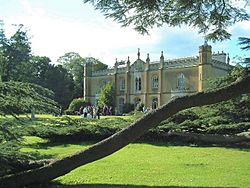Missenden Abbey facts for kids

"Missenden Abbey" - country house dating from 1574
|
|
| Monastery information | |
|---|---|
| Order | Arrouasian (Augustinian) |
| Established | 1133 |
| Disestablished | 1538 |
| Mother house | Arrouaise Abbey |
| Diocese | Diocese of Lincoln |
| People | |
| Founder(s) | William de Missenden |
| Site | |
| Location | Great Missenden, Buckinghamshire |
| Coordinates | 51°42′03″N 0°42′10″W / 51.700759°N 0.702853°W |
| Grid reference | SP8901 |
Missenden Abbey was once a special religious building called a monastery. It was founded in 1133 in Great Missenden, Buckinghamshire, United Kingdom. Monks from the Arrouasian order, who followed the rules of Saint Augustine, lived and prayed there. The abbey was closed down in 1538, and its church was taken apart. Later, in 1574, a large house was built on the same spot. This house, also called Missenden Abbey, still stands today. It has been changed many times over the years, getting its current look in the early 1800s. Sadly, a fire damaged the house in 1985, but it was rebuilt.
Contents
The Abbey's Story
How the Abbey Began
Missenden Abbey was started around 1133 by William de Missenden, who owned the land nearby. Early records show that seven religious men, called canons, came from a church in France to live there. These canons belonged to the Arrouasian order, which was a type of Augustinian group. This made Missenden Abbey the first monastery of its kind in Buckinghamshire.
The Arrouasian canons were very similar to other Augustinian groups. They followed a set of rules for their daily lives, focusing on prayer, study, and community work.
Challenges in the 1400s and 1500s
Over the years, the abbey faced some difficulties. When a bishop named William Grey visited between 1431 and 1436, he found that there weren't enough canons to do all the religious duties. He also noted that some of the abbey's buildings needed fixing.
Later, in 1518, another bishop, William Atwater, visited and found that the rules at the abbey were not always followed strictly. He also saw that the dining hall needed repairs.
In 1530 and 1531, Bishop John Longland visited. He discovered the abbey was in debt, and all its buildings needed repairs. He also found that the abbot, John Fox, was letting a non-religious person control the abbey's money and goods. Because of this, Bishop Longland removed Abbot Fox from his position.
The Abbey Closes Down
Missenden Abbey was officially closed in 1538. This was part of a bigger event in England called the Dissolution of the Monasteries, when many religious houses were shut down by the king. The abbey church was pulled down in the same year. The last abbot, John Otwell, later got married and passed away in 1552.
What the Abbey Looked Like
We don't have a full map of the medieval monastery, but we can guess what it looked like from old records and digs. The main church, dedicated to the Virgin Mary, was on the north side of the cloister (a covered walkway). This was a common layout for monasteries.
Archaeologists have found decorated stonework, suggesting the church was built in a Romanesque style. It was also home to the largest bell in Buckinghamshire, which weighed over 2.5 tons! The original church building was about 300 yards east of where the current house stands.
The Country House Today
Building the New House
After the abbey was closed, a large country house was built on the same spot in 1574. This new house, also called "Missenden Abbey," was built where the old cloisters used to be. It even used some of the stones and parts from the old monastery. The house was changed and updated in the 1600s and 1700s.
Between 1806 and 1814, the house was redesigned in a "Regency Gothic" style for its owner, John Ayton. This style gave it features like castle-like walls, corner towers with narrow windows, and pointed roofs.
Fire and Modern Use
In 1983, the building was given a special protection status, meaning it was an important historical building. However, in 1985, a big fire badly damaged the house. It destroyed much of the inside, including a very old roof from the 1400s or 1500s, which was a rare piece of history.
After the fire, the house was rebuilt and some of its rooms were redesigned. Since the mid-1990s, Buckinghamshire New University has owned Missenden Abbey. Today, it is used as a place for conferences and also for weddings.


